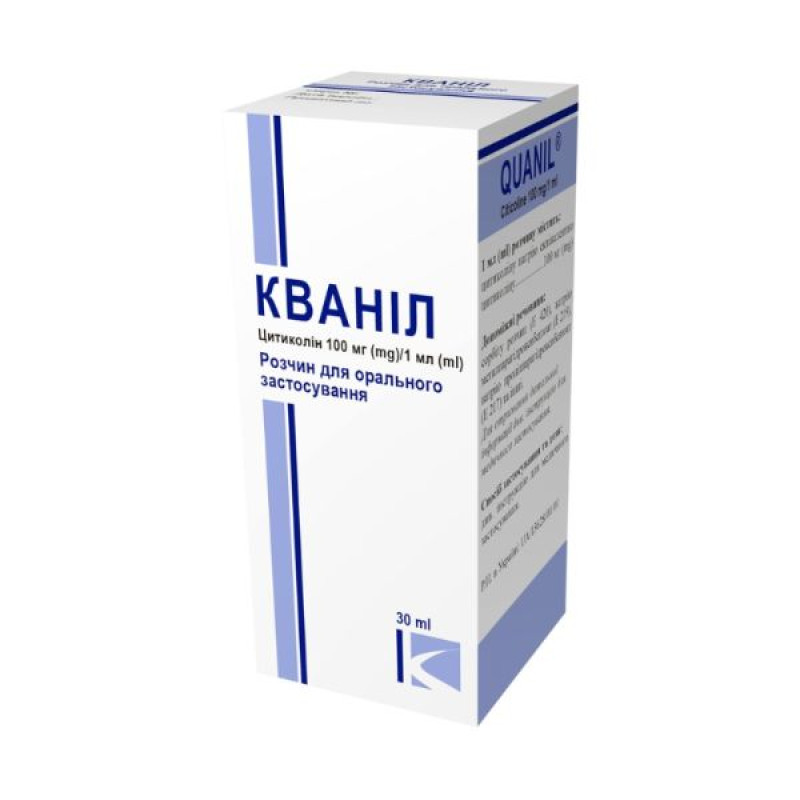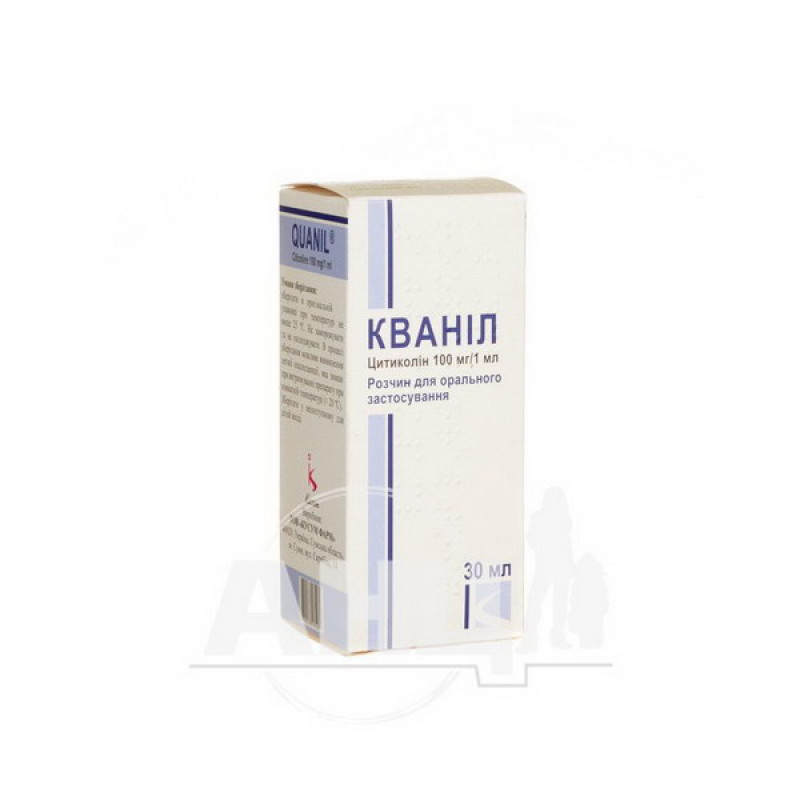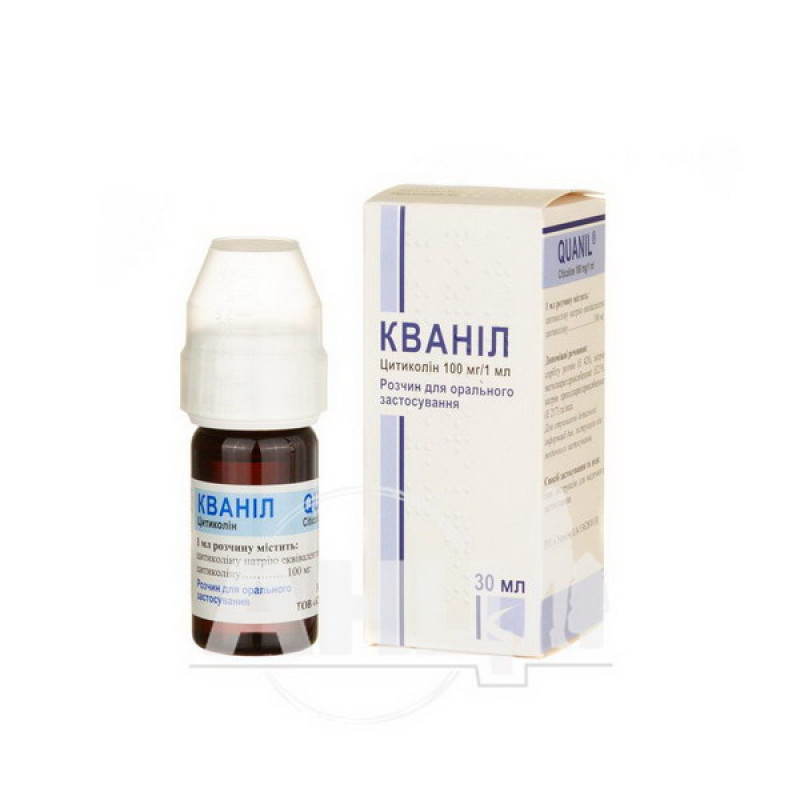Kvanyl oral solution 100 mg/ml bottle 30 ml

Instructions Kvanyl oral solution 100 mg/ml bottle 30 ml
Composition
active ingredient: citicoline;
1 ml of solution contains citicoline sodium equivalent to citicoline 100 mg;
excipients: sorbitol solution (E 420), glycerin, sodium methyl parahydroxybenzoate (E 219), sodium propyl parahydroxybenzoate (E 217), propylene glycol, sodium citrate, sodium saccharin, potassium sorbate, strawberry flavoring, anhydrous citric acid, purified water.
Dosage form
Solution for oral use.
Main physicochemical properties: clear colorless liquid.
Pharmacotherapeutic group
Other psychostimulants and nootropics. ATX code N06B X06.
Pharmacological properties
Pharmacodynamics
Citicoline stimulates the biosynthesis of structural phospholipids of neuronal membranes, which is confirmed by magnetic resonance spectroscopy. Due to this mechanism of action, citicoline exhibits the functioning of such membrane mechanisms as the work of ion exchange pumps and receptors, the modulation of which is necessary for the normal conduction of nerve impulses. Due to its stabilizing effect on the neuronal membrane, citicoline exhibits anti-edematous properties that contribute to the reabsorption of brain edema.
Experimental studies have shown that citicoline inhibits the activation of certain phospholipases (A1, A2, C, and D), reducing the formation of free radicals, preventing the destruction of membrane systems, and preserving antioxidant defense systems such as glutathione.
Citicoline preserves the energy reserves of neurons, inhibits apoptosis, and stimulates the synthesis of acetylcholine.
It has been experimentally proven that citicoline also exhibits a preventive neuroprotective effect in focal cerebral ischemia.
Clinical studies have shown that citicoline significantly increases functional recovery rates in patients with acute ischemic stroke, which coincides with a slowdown in the growth of ischemic brain damage according to neuroimaging data.
In patients with traumatic brain injury, citicoline accelerates recovery and reduces the duration and intensity of post-traumatic syndrome.
Citicoline improves the level of attention and consciousness, cognitive and neurological disorders associated with cerebral ischemia, and helps reduce the manifestations of amnesia.
Pharmacokinetics
Citicoline is well absorbed after oral administration. After administration of the drug, a significant increase in plasma choline levels is observed. When administered orally, the drug is almost completely absorbed. Studies have shown that the bioavailability after oral and intravenous administration is almost the same.
The drug is metabolized in the intestines and liver to form choline and cytidine.
After administration, citicoline is widely distributed in brain structures with rapid incorporation of the choline fraction into structural phospholipids and the cytidine fraction into cytidine nucleotides and nucleic acids. In the brain, citicoline is incorporated into cellular, cytoplasmic and mitochondrial membranes, participating in the construction of the phospholipid fraction.
Only a small amount of the dose is found in the urine and feces (less than 3%). Approximately 12% of the dose is excreted through exhaled CO2. During the excretion of the drug with urine, two phases are distinguished: the first phase - for 36 hours, in which the rate of excretion decreases rapidly, and the second phase - in which the rate of excretion decreases much more slowly. The same phasic nature is observed in excretion through the respiratory tract. The rate of CO2 excretion decreases rapidly for about 15 hours, then decreases much more slowly.
Indication
- Stroke, acute phase of cerebrovascular disorders and treatment of complications and consequences of cerebrovascular disorders.
- Traumatic brain injury and its neurological consequences.
- Cognitive and behavioral disorders due to chronic vascular and degenerative cerebral disorders.
Contraindication
- Hypersensitivity to the components of the drug.
- Increased tone of the parasympathetic nervous system.
Interaction with other medicinal products and other types of interactions
Citicoline enhances the effect of levodopa. The drug should not be prescribed simultaneously with drugs containing meclofenoxate.
Application features
If you have been told by your doctor that you have an intolerance to some sugars, contact your doctor before taking this medicine as this medicine contains sorbitol solution. Sodium propyl parahydroxybenzoate (E 217), sodium methyl parahydroxybenzoate (E 219), which are contained in the medicine, may cause allergic reactions (possibly delayed).
Use during pregnancy or breastfeeding
There are no adequate data on the use of citicoline in pregnant women. Data on the excretion of citicoline into breast milk and its effect on the fetus are absent. Therefore, during pregnancy or breastfeeding, the drug should be prescribed only if the expected benefit to the mother outweighs the potential risk to the fetus.
Ability to influence reaction speed when driving vehicles or other mechanisms
In some cases, some adverse reactions from the central nervous system may affect the ability to drive or operate complex machinery.
Method of administration and doses
The drug Kvanil is used orally, regardless of food intake.
The recommended dose for adults is 500 mg (5 ml) to 2000 mg (20 ml) per day, divided into 2–3 doses.
The drug, pre-mixed with a small amount of water, is taken using a measuring cup. The measuring cup must be rinsed with water after each use. A plastic disposable syringe without a needle can be used to measure doses.
The dosage of the drug and the duration of treatment depend on the severity of the brain lesions and are determined individually by the doctor.
Elderly patients do not require dose adjustment.
Children
Experience with the use of the drug in children is limited.
Overdose
Cases of overdose have not been described.
Adverse reactions
From the side of the central and peripheral nervous system: severe headache, vertigo, hallucinations.
From the cardiovascular system: arterial hypertension, arterial hypotension, tachycardia.
Respiratory system: shortness of breath.
On the part of the digestive system: nausea, vomiting, diarrhea.
On the part of the immune system: allergic reactions, including: rash, hyperemia, exanthema, urticaria, purpura, itching, angioedema, anaphylactic shock.
General reactions: chills.
Expiration date
2 years.
Storage conditions
Store in the original packaging at a temperature not exceeding 25°C. Do not freeze or refrigerate. During storage, a slight opalescence may occur, which disappears when the drug is kept at room temperature (≈ 20°C). Keep out of the reach of children.
After first opening the bottle, store the drug for no more than 4 weeks.
Packaging
30 ml or 100 ml in bottles No. 1. Each bottle is packed in a cardboard box together with a measuring cup.
Vacation category
According to the recipe.
Producer
"KUSUM FARM" LLC.
Location of the manufacturer and address of its place of business
Ukraine, 40020, Sumy, Skryabina St., 54.
There are no reviews for this product.
There are no reviews for this product, be the first to leave your review.
No questions about this product, be the first and ask your question.





